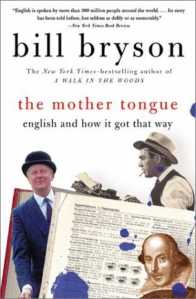Hardcover, $14.99
1990
William Morrow
245 pages
Bill Bryson is a journalist and, apparently, amateur comedian. His own website describes him as “one of the most beloved authors of our time.” Really? Have YOU ever heard of him? Even if you have, it’s pretty unlikely that you love him. My personal feelings about Bill are mixed–after all, he wrote a book on a fascinating subject, but he didn’t write it to my satisfaction! Bill, I’m gonna give you “one of the most mediocre and not entirely terrible authors of our time.”
First, I have to make some editorial remarks about this book. It has one of the worst jacket designs I’ve ever seen. Shakespeare I get, but random purple ink splotches? Come one. Second, when you’re writing any book, but especially one that has chapters on grammar, usage, and spelling, you should get a great copyeditor. It’s one thing to rebel against ridiculous rules of grammar, but quite another to construct sentences in which clarity is lost. (In explaining the different meanings for number words in the U.S. and Britain, Bryson says, “a decillion in America is one plus thirty-three zeros.” But any mathematician can tell you that one plus any number of zeros is still going to be ONE, not the number Bryson is trying to reach.) And Bryson has a tendency to contradict himself, as in two neighboring paragraphs that begin “English is the most important language in the world” and “English is not always spoken as widely or as enthusiastically as we might like to think,” respectively. (Disclaimer: Bryson freely admits that he has little respect for the grammarians who impose rules on us such as: don’t begin a sentence with a conjunction or end with a preposition. Sometimes it’s hard to tell if mistakes are on purpose or not.)
And now for Bryson himself. Arrogance and a strange, geeky sense of humor are what I got out of his writing. He spends 2 pages giving examples of grammar mistakes made by eminent English usage authorities. This only serves to make Bryson sound like a jerk. He also has a propensity for using unnecessarily obscure words and for making broad statements that don’t really hold water. E.G.: “We tend to regard other people’s languages as we regard their cultures–with ill-hidden disdain.” I don’t know about you, but I don’t feel any disdain toward (or is it towards?) other languages or cultures. Bill Bryson, on the other hand….Or how about his suggestion that “the Italians even have a word for the mark left on a table by a moist glass” and English-speakers don’t. I’ve always known that to be a “ring.” Apparently Britons say “shoelace” and Americans say “shoestring.” Sorry, guys, I’ve got to stop and tie my shoestring. Really?? Bryson also seems to think the L in words like “folk” and “alms” is silent…is that true? I pronounce those L’s! “Bollix is commonly used in America…” If any American has ever seen or heard this word used in America, please let me know.
However, Bill does make a few good points, most notably that it’s annoying when New Yorkers say they stand “on line” and take their coffee “regular” (meaning with milk). And his information, minus all the editorializing and dumb jokes, is actually very interesting. The sad truth is, though, that none of Bryson’s book seems to be based on original research. He sites other writers on nearly every page and has little or nothing in the way of primary sources. One might do better with one of the titles listed in Bryson’s extensive bibliography. Or better yet, try a quick search on Amazon. This book, through no fault of the author’s, was written 20 years ago. Though nothing in the history of English has changed in that time, certainly new research has come to light and statistics have changed. An updated version of The Mother Tongue would require at least one chapter on George W. Bush.
Filed under: Reviews | Tagged: Bill Bryson, book review, grammar, The Mother Tongue | 2 Comments »





 Colum McCann
Colum McCann








